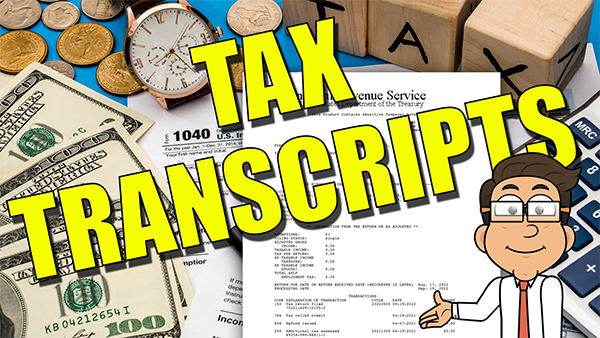Unlocking The Secrets Of Your Tax Account: Your Tax Transcript Explained
When it comes to understanding your tax account, one of the most important documents at your disposal is your tax transcript. This essential piece of paperwork holds the key to unlocking the secrets of your tax history and can provide valuable insights into your financial situation. Whether you are a seasoned taxpayer or new to the world of taxes, understanding your tax transcript is crucial for making informed decisions about your finances. In this blog post, we will demystify the tax transcript, explore its different variations, and explain how it influences tax resolution services and strategic tax planning.
Demystifying the Tax Transcript: A Gateway to Your Tax History
Peeling back the layers of your financial narrative, your tax transcript stands as a testament to your dealings with the IRS. This document is not just a series of numbers and codes; it’s a reflection of your income trajectory, the tax credits you’ve leveraged, and the payments you’ve dispatched to the treasury. It’s akin to having a detailed ledger, one that encapsulates your fiscal interactions over the years, offering a panoramic view of your financial footprint.
Diving into your tax transcript can illuminate past transactions and decisions, highlighting both your financial acumen and areas where guidance could enhance your outcomes. It’s a foundational tool, especially when discrepancies or anomalies emerge, casting shadows of doubt over your tax history. Armed with this compendium, you can pinpoint these irregularities, providing a concrete basis for any needed amendments or discussions with the IRS.
This detailed record serves not only as a beacon for rectifying past missteps but also as a guide for future tax-related endeavors. By understanding the narrative laid out in your tax transcript, you’re better equipped to navigate the complexities of the tax landscape, making informed decisions that align with your financial goals. It’s a crucial step in demystifying the tax process, transforming what may seem like an impenetrable wall of figures and regulations into a clear path forward.
The Different Flavors of Tax Transcripts: Which One Do You Need?
The IRS offers a veritable menu of tax transcripts, each tailored to meet specific informational needs, much like choosing the right tool for a job. The Tax Return Transcript is akin to a snapshot, providing a summary of your filed return, perfect for those moments when you need to verify past income or secure a mortgage. For a more detailed dive, the Tax Account Transcript reveals adjustments post-filing, shining a light on the evolving narrative of your tax account—ideal for resolving discrepancies or understanding IRS actions.
The Record of Account Transcript merges the two, offering a comprehensive overview that satisfies most inquiries with a single document. If your focus is on wage and income information reported by employers, banks, and other financial institutions, the Wage and Income Transcript becomes your go-to guide, essential for precise tax preparation and planning. And for a quick verification of non-filing or IRS acknowledgment of your tax return, the Verification of Non-filing Letter and Tax Return Database View (RTV) serve distinct, yet critical roles.
Navigating the selection process begins with understanding your immediate need: Are you verifying past income, resolving an issue, or planning ahead? Your answer will illuminate the path to the specific transcript that holds the key to unlocking your tax narrative, ensuring you gather the precise data needed to inform your decisions and actions.
How Your Tax Transcript Influences Tax Resolution Services
In the intricate world of tax resolution, your tax transcript acts as a critical navigator, charting the course through the complexities of resolving disputes with the IRS. For professionals in the realm of tax resolution services, this document is indispensable. It provides a detailed chronology of your tax history, spotlighting areas that may require rectification or negotiation. Imagine your tax transcript as a comprehensive map of your financial journey with the IRS, each entry a waypoint that has shaped your current standing. This map enables tax resolution experts to pinpoint precise locations where disputes might arise and strategize an effective path to resolution. It’s the starting point for any dialogue with the IRS, furnishing resolution services with the insights needed to advocate on your behalf effectively. Without this foundational document, navigating the resolution process could be likened to setting sail without a compass, vastly complicating the journey toward settling any tax-related issues. In essence, your tax transcript is not just a record; it’s a powerful tool wielded by tax resolution services to steer you clear of turbulent waters, ensuring a smoother passage to resolving your tax concerns.
Navigating the Numbers: Key Sections of Your Tax Transcript Explained
Diving into the labyrinth of numbers that comprise your tax transcript can seem daunting at first glance. Yet, understanding these figures is akin to decoding a map of your financial journey with the IRS. Among the myriad of sections, several stand out for their importance in shaping your tax narrative. The Adjusted Gross Income (AGI) serves as a cornerstone, influencing your eligibility for certain tax deductions and credits, directly impacting your fiscal health. Total income reported lays bare the breadth of your financial landscape, offering insights into your earnings over the fiscal period. Tax deductions claimed illuminate the strategies you’ve employed to minimize your taxable income, shedding light on savvy financial planning or potential areas for improvement. Equally, the record of any tax payments made reveals your commitment to meeting your tax obligations, providing a clear indicator of your fiscal responsibility. Grasping the significance of these sections empowers you to navigate your financial trajectory with greater confidence, ensuring that every decision is informed and every opportunity for optimization is seized. This deeper understanding not only demystifies the numerical tapestry of your tax transcript but also arms you with the knowledge to sculpt a more favorable financial future.
The Role of Tax Transcripts in Strategic Tax Planning
In the realm of strategic tax planning, the utilization of your tax transcript is akin to uncovering a treasure map, guiding you through the intricate maze of tax laws to unearth potential savings and optimize your financial strategy. As you navigate through the detailed account of your past filings, your transcript reveals not just a history, but a blueprint for future tax efficiency. Identifying previously overlooked deductions or credits becomes a strategic endeavor, transforming overlooked details into valuable assets for your fiscal planning. This deep dive into your financial past facilitates a proactive approach to tax planning, allowing for adjustments that align with ever-evolving tax regulations and personal financial goals. It’s an analytical process, one that requires a keen eye for detail and an understanding of the broader tax implications of your financial decisions. By leveraging this comprehensive overview, you embark on a path not just of compliance, but of optimization, ensuring that every element of your financial activity is tuned to your best advantage. In this light, your tax transcript is more than a record—it’s a catalyst for informed, strategic decision-making that can significantly influence your financial future.
Requesting Your Tax Transcript: A Step-by-Step Guide
Embarking on the journey to request your tax transcript is a process marked by simplicity and accessibility. To initiate this voyage online, the first step is to anchor yourself on the IRS’s official website, where you’ll be prompted to establish an account. This virtual portal requires a few key pieces of information to confirm your identity, ensuring that your financial voyage is both secure and personalized. For those who favor a more traditional route, the IRS accommodates with Form 4506-T. Completing this document is akin to charting your course on paper, whereupon mailing it to the designated IRS address serves as setting sail toward obtaining your tax transcript. Whether you choose the speed of digital navigation or the steady course of postal delivery, each pathway is designed to guide you to the same destination: obtaining a clear and comprehensive view of your tax history. This step, while seemingly straightforward, is a crucial maneuver in your financial odyssey, equipping you with the knowledge and documentation necessary to navigate future fiscal waters with confidence and precision.
Common Questions and Concerns About Tax Transcripts Addressed
Navigating the realm of tax transcripts often gives rise to a tapestry of queries and uncertainties. Many wonder how to decode the intricate details of their tax transcript, confront the challenge if inaccuracies are spotted, and question the longevity of these documents’ availability. Addressing these common concerns, it’s pivotal to approach your tax transcript as a dynamic dossier of your fiscal interactions with the IRS. Should you stumble upon discrepancies, it’s akin to discovering navigational errors on a charted course; immediate steps to rectify these through amendments or consultations with tax professionals are crucial. As for the shelf life of these documents, tax transcripts hold their relevance for a period, typically the last three years, making them a critical resource for recent fiscal analyses but less so for distant tax years. Embracing these insights not only enhances your understanding but equips you with the confidence to harness your tax transcript as a tool for informed financial navigation. For more information, please visit Cents Savvy Tax Resolution and Preparation

